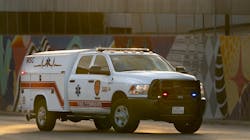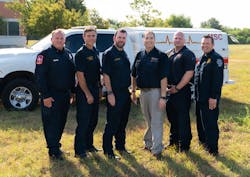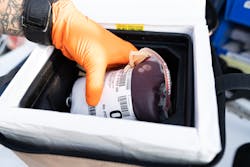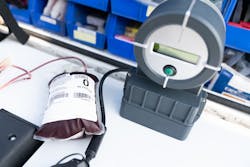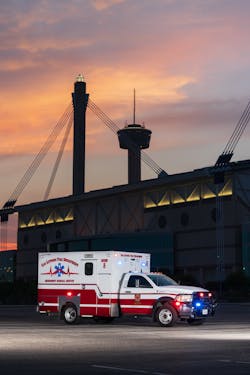There are more than 60,000 hemorrhagic deaths per year in the U.S., about half of which occur in the prehospital setting and are associated with trauma. Additionally, gastrointestinal bleeds, perioperative hemorrhage, fistula bleeds, variceal bleeds and obstetric bleeds are some of the causes of medical prehospital hemorrhage. Every year hemorrhagic deaths account for nearly 1.9 million deaths worldwide and most affect young people.
The military transfused nearly one million units of cold-stored whole blood in World War II, the Korean War and Vietnam War. Whole blood was the answer to the treatment of traumatic hemorrhagic shock. After the Vietnam War there was an effort to conserve blood and target specific deficiencies. This was accomplished by breaking blood down into its three components; red blood cells, plasma and platelets.
To this day, very few hospitals or blood centers carry whole blood. But the military and San Antonio, TX, Fire Department (SAFD) revived the process that worked most effectively on the battlefield. Stop the bleeding, if possible, and give the patient blood.
The birth of a whole blood program
SAFD EMS and UT Health San Antonio Office of the Medical Director (OMD) employ the concepts of damage control resuscitation and point of injury care. These strategies include permissive hypotension, minimization of crystalloid resuscitation, control of hypothermia, prevention of acidosis and early use of a balanced blood-based resuscitation. Treating the patient’s hemorrhagic shock at point of injury, with whole blood, may be as important to patient outcome as surgical treatment.
UT Health San Antonio and South Texas Regional Advisory Council submitted a grant application to the San Antonio Medical Foundation to kick start a prehospital whole blood program in 2017. The grant was given to South Texas Blood and Tissue Center (STBTC) to buy testing, storage and other necessary equipment to start the Brothers in Arms blood donation program that provides whole blood to the entire South Texas trauma region. Helicopters started carrying low titer O + whole blood (LTOWB) in January of 2018 and SAFD EMS started carrying LTOWB on Oct. 1, 2018.
For the first time in the history of the U.S., this program is making whole blood available to an entire region and a metropolitan city. University Hospital, the region’s county hospital and level 1 trauma center, is a critical partner that acts as the region’s primary blood rotation center and allows minimal outdate of blood products. LTOWB is good for 35 days. The first 14 days of its shelf-life the blood is placed on a SAFD vehicle and if it is not used it is returned to the STBTC to be placed in University Hospital for the remaining 21 days of its shelf-life. This allows the whole blood program to minimize blood waste.
Multiple partners make up the whole blood consortium that meets weekly for performance improvement monitoring, equipment validation and the continual effort to get more whole blood to the entire system. This integrative regional system of care with a consensus-driven approach involves multiple stakeholders and is the true ingredient to the success of the whole blood program.
Considerations for deployment
Deploying whole blood at the command staff level involves an understanding of state and local laws and regulations. It also requires money, equipment, training, sound operational planning and a collaboration with multiple partners—all things that fire departments are adept at already. Asking the ESD, city, state or governing entity for resources and permission requires coordination and a clear plan forward.
Deploying whole blood at an operational level involves an understanding of where the blood will be located, how much blood will be needed, who will receive the blood, how the blood will be kept cold and then warmed before transfusion.
A rural EMS system might need two units of blood per vehicle and an urban system might only need one unit of blood per vehicle. To keep the whole blood at near-freezing temperature requires a plan unique to the department. A small department that runs fewer calls can likely keep blood in a refrigerator in the station. In a busier system, units might not return to the station for many hours and a mobile blood cooler or refrigerator transport system must be implemented.
In SAFD EMS there are two coolers per unit. One cooler is kept on the response vehicle for 24 hours with the unit of whole blood readily available. In the morning, coolers are swapped and the blood is placed in the cooler that was recently removed from the freezer; this will keep the blood at Food and Drug Administration approved temperatures for the entire 24-hour shift. An operational plan to transfuse this more viscous product into the patient is needed. It can be difficult to push the blood through a smaller intravenous gauge or an intraosseous needle. Blood transfusion will require an appropriate pressure system.
If it is not possible to have whole blood on every vehicle, a dispatch algorithm must be built to make sure whole blood is available on scene when needed. If blood is not available on every unit, which will likely be the case for most systems, then a process for a supervisor or squad unit to deliver whole blood to the scene needs to be developed. The logistics of field delivery of whole blood require continual analysis and improvement processes to create best practice.Logistically we had to come up with an entirely novel solution to transfuse whole blood in a busy urban EMS system. Having a stationary blood refrigerator would not work as our ambulances are often out on calls all day. So, we have a cooler that can keep the blood from 1–10 degrees C for up to 50 hours. We have a blood warmer that warms the blood to body temperature almost immediately. We have blood tubing with blood filters. We use two pressure systems to get blood into patients; we use a pressure infuser and we have an in-line hand pump in the tubing that allows us to transfuse 500mL of blood at 38 degrees C in under five minutes.
Part of a solution
I have been asked multiple times, why we need whole blood in a metropolitan city with two level 1 trauma centers. Reviewing a year and a half of data, we determined in San Antonio and Bexar County it takes 28.8 minutes, on average, from 9-1-1 EMS call to get a trauma alert patient requiring a massive transfusion to definitive care at a trauma hospital.
Research shows if a patient is going to die from a gunshot wound to the chest or blunt injury, they are going to die in less than 30 minutes and mortality in traumatic torso injury occurs long before the golden hour. According to these numbers, the critically ill San Antonian suffering from a blunt or penetrating injury would die as we were transporting them to the ER or as we were wheeling them through the hospital doors.
M—massive hemorrhaging
A—airway
R—respirations
C—circulation
H—hypothermia
E—eye injuries
S—spinal motion restriction
SAFD EMS annually sends EMT Basics and all paramedics to a cadaver lab to practice the MARCHES concepts by performing cricothyrotomies, instrument thoracostomies, intubations, advanced airway control, tourniquet application and training on many other advanced interventions.
MARCHES and whole blood are how SAFD and the OMD address the concepts of damage control resuscitation and point-of-injury care.
I have coined San Antonio as Resuscitation City USA. We as a city and a region feel we can and should do better for our patients in hemorrhagic shock. If a patient is in hemorrhagic shock, SAFD EMS, UT Health San Antonio OMD and the whole blood consortium are going to respond with the world’s most advanced point-of-injury care, we promptly transfuse blood on scene for medical and traumatic emergencies. We have saved lives and we will continue to save lives with blood.
Any first-of-its-kind program takes conviction, courage and confidence to succeed, and whole blood pioneers have deployed all three in leading the charge to save lives. Consider the same for your community.
UT Health San Antonio, SAFD, STRAC, STBTC and vested partners host the National Whole Blood Summit and will soon be hosting a whole blood academy for departments to learn how to implement a whole blood program in your region.
For more information:
Wholebloodacademy.com
Southtexasblood.org/brothers
Strac.org/blood
NWBSummit.org
References
Chang R, Holcomb J. Optimal Fluid for Traumatic Hemorrhagic Shock. Crit Care Clin. 2017 Jan; 33(1): 15–36.
Cannon JW. Hemorrhagic shock. N Engl J Med. 2018;378(4):370–379
Weymouth W, Long B, et al. Whole Blood in Trauma: A Review for Emergency Clinicians. J Emerg Med. 2019 May;56(5):491-498.
Zhu C, Pokorny D, et al. Give the trauma patient what they bleed, when and where they need it: establishing a comprehensive regional system of resuscitation based on patient need utilizing cold-stored, low-titer O + whole blood. Transfusion, 2019;59;1429–1438
TRACIE ASPR. Mass shootings and rural areas [monograph on the Internet]. 2018. Available from: https://asprtracie.s3.amazonaws.com/documents/aspr-tracie-the-exchange-newsletter-issue-7-508.pdf
Alarhayem A, Myers J, et al. Time is the enemy: Mortality in trauma patients with hemorrhage from torso injury occurs long before the “golden hour”. Am J Surg. 2016 Dec;212(6):1101-1105
Winckler C, Wampler D, et al. Position Statement for the Management of Patients in Hemorrhagic Shock [online]. EMS World, 2019 May. Available from: https://www.emsworld.com/article/1222631/position-statement-management-patients-hemorrhagic-shock
About the Author
C. J. Winckler
C. J. Winckler MD, LP provides daily clinical supervision, via on-scene medical direction, online medical direction and performance improvement processes, to more than 1,700 San Antonio Fire Department providers. Winckler implemented a novel clinical clearance process for law enforcement that allows navigation of emergency-detained patients directly to psychiatric facilities. He also led the implementation of a groundbreaking whole blood deployment process and transfusion guideline for patients in hemorrhagic shock on scene, which is the first of its kind for a metropolitan EMS system in the United States.
